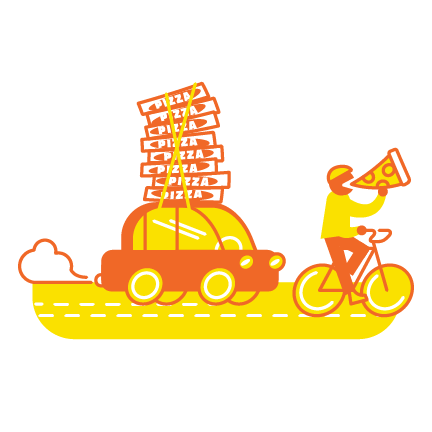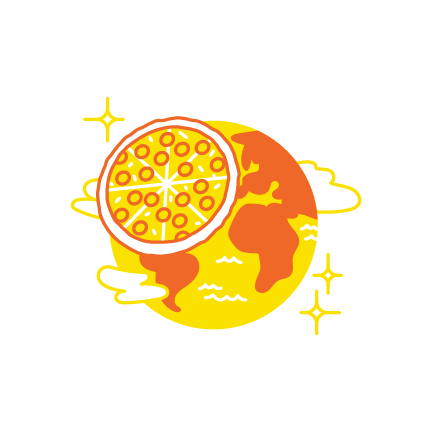Climate change comes with some big numbers, especially when you’re talking about how much greenhouse gas emissions humans are producing.
To help translate these numbers, we spoke with Keighan Gemmell, a climate expert doing a PhD in atmospheric chemistry at the University of British Columbia.
Fossil fuels are an energy source we use to power cars, planes and factories. Pizza is also an energy source for humans, which we digest to help us do things like ride bikes.

If a human ate a slice of pizza, they’d get enough energy to bike about five kilometres moving 10 kilometres an hour.
If a car also wanted to travel five kilometres at the same speed, it would need the energy equivalent of 200 slices of pizza.
Many machines aren't able to use the energy in fossil fuels as efficiently as the human stomach uses pizza.
Let’s stick with the pizza metaphor for a minute and calculate how big a pizza would be if it weighed the same as Metro Vancouver’s annual emissions.
A medium Dominos pizza is 12 inches in diameter, weighs around one kilogram and feeds four people—or one if you’re very hungry!

In 2019 Metro Vancouver produced 14.8 million tonnes of CO2 equivalent, mostly from cars and houses heated by gas-burning furnaces.
If we turned those emissions into a pizza, it would be about the total size of British Columbia and Alberta, because it would be about 1300 kilometres in diameter, Gemmell says. That pizza could feed 37 million people!
British Columbia produced 64.6 megatonnes Say what? A megaton is one million tonnes. The Golden Gate Bridge weighs just under one megaton. of CO2 equivalent in 2020, the most recent year of data available. There’s a couple different ways to conceptualize that number, Gemmell says.
The dome of Science World could fit 100 tonnes of CO2 inside it. That might seem like a lot, but that’s only 0.0002 per cent of the total emissions B.C. produced in 2020. If you scooped a big handful of sand and picked out one grain of sand from that handful, half of that grain of sand would be 0.0002 per cent of the handful of sand.
Let’s compare the weight of B.C.’s annual emissions to other objects.
If you had 64.6 megatons of water that would be enough to fill BC Place Stadium up to the ceiling 300 times, Gemmell says.
Or, if you had 64.6 megatons of steel, you could build 6,500 BC Ferries, because the big ships weigh around 10,000 tonnes each, he says. That’s a lot of ferries!
Now let’s look at global emissions, which were 37 billion tons in 2019. That’s a huge amount — so we’re comparing it to the biggest object we know: Mount Everest.
At 8,849 metres tall this mountain is considered the highest point on Earth and weighs around 350 trillion pounds. That’s huge! But humans will produce the same weight of greenhouse gasses in less than four years, Gemmell says.
Even with all of these greenhouse gasses, the atmospheric composition hasn’t changed — it’s still made up of 78 percent nitrogen, 21 percent oxygen, 0.9 percent argon and the last 0.1 percent all the other gasses, including CO2. CO2 is still a tiny, tiny fraction of the total atmosphere—but even a change in a tiny fraction of the total atmosphere can have huge, global impacts.
Curious about the science of climate BC?
Explore the unfolding science and timeless solutions for regenerating our planet at Change Reaction.
